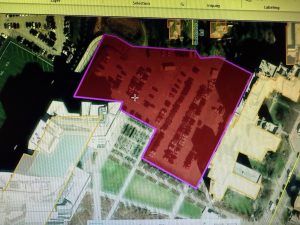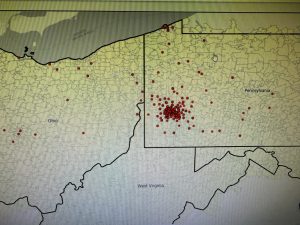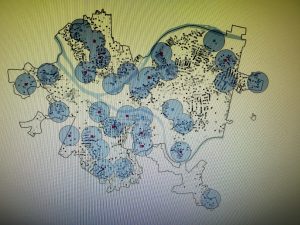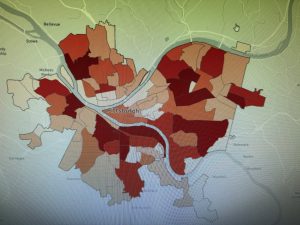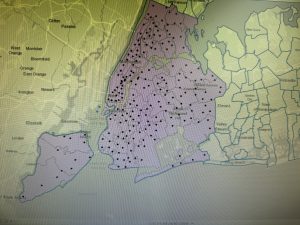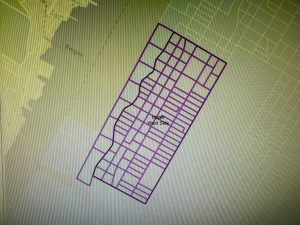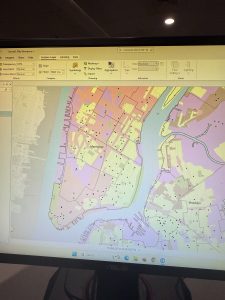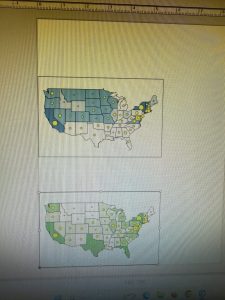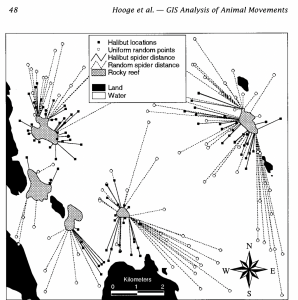Chapter 4:
There were 5 key points for chapter 4 – why map density, deciding what to map, two ways of mapping density, mapping density for defined areas, and creating a density surface.
The reason that we map density is because it shows where the highest concentration of features is. It looks at patterns rather than locations and it’s helpful for mapping areas of different sizes. To map those areas, you have to shape them based on density value or surface. You have to look over what data you have and decide if you want to then map features or feature values.
There are 2 specific ways of mapping density. Those are by defined area or by density surface. You would use mapping by area when you have the data already summarized by area. You would use mapping by density surface when you have individual locations. This chapter specifically goes into those two kinds of mapping in a lot more detail including how they are used, the calculations needed and what the results could look like.
Mapping density for defined areas – you can make this in two ways. One is by showing density for each area graphically using a dot density map and the other is calculating a density value for each area and then shading based on that. An example of the calculation for that would look like this: pop_density = total pop/(area / 27878400). It also dives into how you would create that dot density map.
Creating a density surface – these are created by GIS as raster layers. It helps show where point or line features are. There are a few things that go into calculating density surface, which include cell size, search radius, calculation method, and radius. The chapter goes over each of those parameters and what they do. To display a density surface you can use things such as graduated colors and contours.
Chapter 5:
The main topics of chapter 5 were why map what’s inside, defining your analysis, three ways of finding what’s inside, drawing areas and features, selecting features inside an area, and overlaying areas and features.
As for why we map inside, it is to help monitor what’s occurring inside it, or to compare several areas. This is important to know whether or not to take action. In order to do this you have to draw a boundary on top of your features to define the analysis. You can find what’s inside of single areas, or several areas. The chapter then goes into more detail on those two. And another important thing to figure out is whether or not they are discrete or continuous features.
When looking at the information you need from your analysis, you’re going to want to find out if you need a list, count, or summary. You then need to see if the features are completely or partially inside.
There are 3 different ways of finding out what’s inside – drawing areas and features, selecting the features inside the area, and overlaying the areas and features. All of which this chapter goes into more detail about. It also goes over different guidelines that will help you choose the best method and how to make those maps. Look at locations and lines, discrete areas, and continuous features.
When using your results there are a few things to look at – counts, frequency, and a summary of numeric attributes. This chapter also goes into a lot of detail on overlaying areas with features including what GIS does, how you would use them and what results you could get out of that. It looks at continuous categories or classes as well which includes a couple different methods: the vector method and the raster method and what the difference is between the two, as well as which one you should use.
Chapter 6:
The main topics for chapter 6 included why map what’s nearby, defining your analysis, three ways of finding what’s nearby, using straight-line distance, measuring distance or cost over a network, and calculating cost over a geographic surface.
In terms of mapping what’s nearby, this is important because GIS can help find what’s occurring within a set distance. You also need to define your analysis and determine whether or not it’s by distance or by travel to or from a feature.
Knowing what information you need is super helpful in creating the best method for your analysis. You can get a list, count or summary and each has their own benefits. Inclusive rings and distinct bands are useful in this as well.
There are 3 different ways of finding what’s nearby – straight-line distance, distance or cost over a network, or cost over a surface and the chapter goes into detail for each of those regarding what they are used for and the pros and cons of each.
Important information for straight-line distance: creating a buffer, getting the correct information which also involves finding features for multiple sources and several distance ranges and making a map.
Important information for features within a distance: getting all the information and again, selecting features near several sources and distance ranges and making a map.
Important information for feature to feature: specifying a maximum distance, getting the information, and making the map. Color coding is used a lot when making maps.. You can use it by distance or source and you can also use things such as spider diagrams and graduated point symbols.
The chapter goes into how to create distance surfaces which is something that has been touched on a few times within these past few chapters. You have to create distance ranges and then decide if they are discrete or continuous. Specifying maximum distance and multiple source features are also important.
When measuring a distance or cost over a network, you want to specify a network layer and use GIS to help you. To assign street segments to centers you can use distance or cost and for setting travel parameters you need to specify turns and stops. It’s important that if you have more than one center, it is specified by GIS. Once GIS has identified the segments, you can find out what’s covered in those segments, including using boundaries and summing as you go.
Lastly, for calculating cost over a geographic surface, it’s important to specify the cost by creating a cost layer. You can modify the cost distance and use barriers to get all the information needed.
